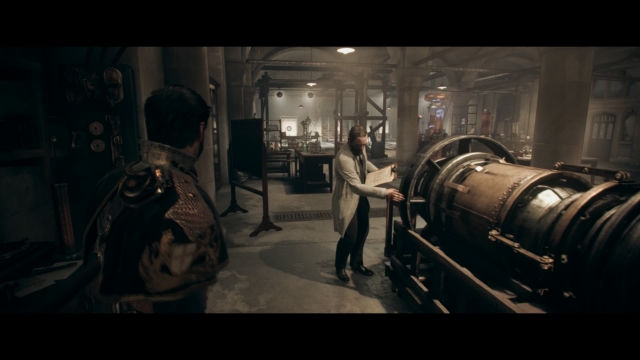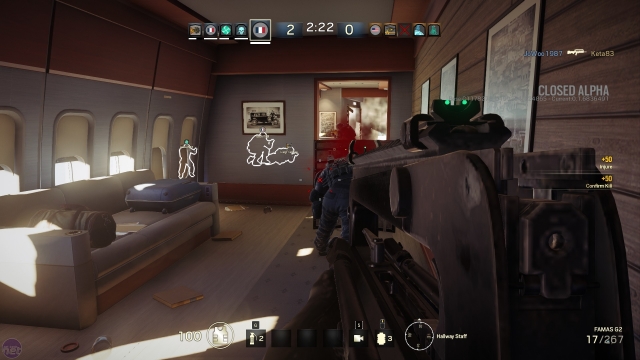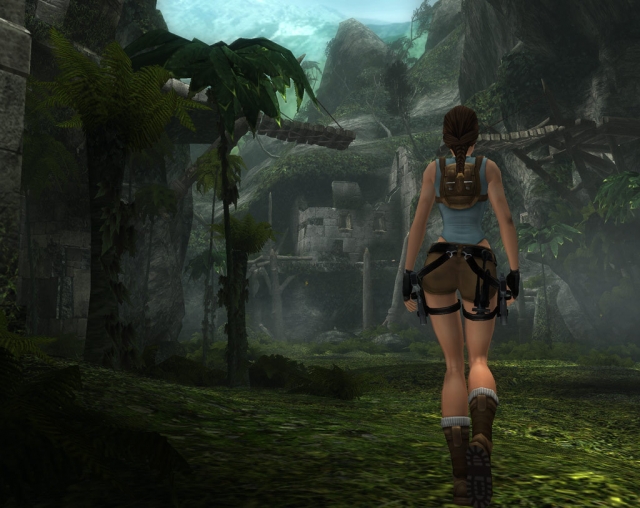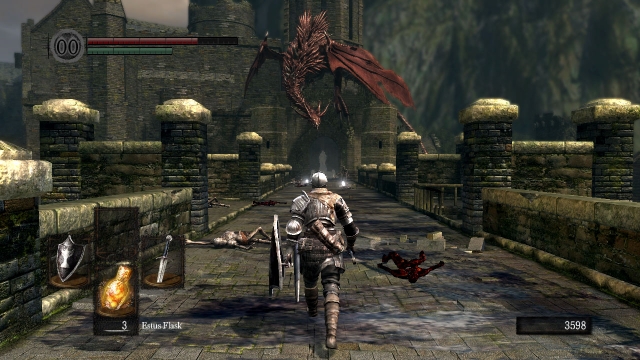
Praise be to Mechanical Experimentation
With the graphic approach to photorealism, it’s becoming increasingly difficult to view videogames as what they actually are: systems, environments constrained by rules telling you what you can do and what you can’t do. One rule may determine the way you jump, others the time a character takes to reload, and alternatively some may simply define how seamlessly you move from one action to the next one. What’s more, visual ‘artificial’ cues—such as pop-ups telling you which button to press—are now more common than in less photorealistic systems, because the graphic quality previously spoke for itself! It is natural that we feel much more frustrated when we’re not able to open a door in The Order: 1886 than in Doom, as the low level of fidelity to reality of Doom triggers a clearer separation from reality, making players expect and tolerate differences between the rules governing the game and what it’s not the game. However, in The Order: 1886, it feels odd not to be able to open the door, as the system’s world clearly intended to emulate reality to great extent, mainly by graphical fidelity. The line between systems and reality, in terms of graphics, is now near impossible to notice.
This intention to match how we play and what we see on the screen has forced many mechanical constraints. The pursuit of polished kinaesthetic mechanics has neglected many of the previously used and old-school ones prevailing in the ‘90s, which were less fluent, more ‘robotic’ or artificial and less realistic. Because indeed, we needed realistic mechanics and animations in order to not make the visuals and the mechanics strangely disagree with one another. We couldn’t have The Evil Within playing like 1992's Alone in the Dark. It is important to note that this process has developed due to the aforementioned graphical photorealist improvement, in order to avoid dissonance between playability and visuals. Anecdotally, Japanese games have not embraced this adaptation and synergy between graphical and mechanical fidelity to reality, at least, not as much a Western developers have. For example, let’s take System Shock. It only takes a second to realise that the mechanics and visuals of this game have nothing to do with the ones found in its successor, System Shock 2. It is clear that both graphics and mechanics have evolved here.
 Embrace low-res What we have now is a trend where videogames, particularly those with creative photorealist pretensions, are enclosed in a set of mechanics with little variation and little space for player mechanical exploration. Those games that look really neat, like The Order: 1886, usually have quite a few restrictions regarding what you can do and where you can go. Not only in terms of which doors to open, but things like which parts of the level you can or can’t access, or how cover-based shooters are much more prevailing now than before. Ironically, we have tried to advance our mechanics by limiting them. As I’ve said, games are governed by rules, taking shape as what we call mechanics. They are designed for a specific set of actions to accomplish a specific set of goals. This creates an environment where every action that the player performs is subjected to a set of norms, greatly constrained by level design, physics engine and enemy programming. Much like in real life, the environment constrains the possibilities of our actions.
Embrace low-res What we have now is a trend where videogames, particularly those with creative photorealist pretensions, are enclosed in a set of mechanics with little variation and little space for player mechanical exploration. Those games that look really neat, like The Order: 1886, usually have quite a few restrictions regarding what you can do and where you can go. Not only in terms of which doors to open, but things like which parts of the level you can or can’t access, or how cover-based shooters are much more prevailing now than before. Ironically, we have tried to advance our mechanics by limiting them. As I’ve said, games are governed by rules, taking shape as what we call mechanics. They are designed for a specific set of actions to accomplish a specific set of goals. This creates an environment where every action that the player performs is subjected to a set of norms, greatly constrained by level design, physics engine and enemy programming. Much like in real life, the environment constrains the possibilities of our actions.
 So much detail and so little interactivity Designers would naturally make a game beatable by means of these rules, but the way they may have in mind is not necessarily the most effective, the one you like the most, the most challenging or the most original. It’s those possibilities designers don’t have in mind, but that are still doable, what makes many old games so engaging for me. Now, paradoxically, the simpler and more independent to one another these rules are, the easier it is to manipulate them and explore mechanically, as a player, the possibilities that are available, even if some involve the intentional use of glitches.
So much detail and so little interactivity Designers would naturally make a game beatable by means of these rules, but the way they may have in mind is not necessarily the most effective, the one you like the most, the most challenging or the most original. It’s those possibilities designers don’t have in mind, but that are still doable, what makes many old games so engaging for me. Now, paradoxically, the simpler and more independent to one another these rules are, the easier it is to manipulate them and explore mechanically, as a player, the possibilities that are available, even if some involve the intentional use of glitches.
I have always felt that games like Counter Strike, whose formula has barely changed since its conception, are much more malleable than the latest Rainbow Six, which arguably include utterly sophisticated and modern kinaesthetics and gameplay. True, in Rainbow Six you can rappel down a building, blow up walls and sledgehammer down barricades, but these actions don’t constitute the player’s result of experimentation with basic mechanics, but ones already implemented into the game by designers. In Counter Strike, however, there’s a vast space for modification and exploration; from crosshairs to different methods to control recoil, lure the opponent or not receive damage from falls, or specific places to hide or reach, not necessarily intended by the game designers.
 You could argue that games like Battlefield 3 had a much bigger space to experiment by modifying and creating new strategies and mechanics, and the game was certainly more modern, sophisticated and —many would argue— ‘realistic’. From hopping on a helicopter mid-air, to making friendly tanks fly by planting C4s underneath; it is true that there are tons of possible actions that the developers didn’t purposely enforce, but the amount of the ones they did is much larger than in Counter Strike (vehicles, classes, larger maps, more weapons, etc.). Inevitably, there’s always space for player mechanical exploration, but the most basic and independent mechanics will always allow for more experimentation, because the rules constraining them are looser, just like in many retro games.
You could argue that games like Battlefield 3 had a much bigger space to experiment by modifying and creating new strategies and mechanics, and the game was certainly more modern, sophisticated and —many would argue— ‘realistic’. From hopping on a helicopter mid-air, to making friendly tanks fly by planting C4s underneath; it is true that there are tons of possible actions that the developers didn’t purposely enforce, but the amount of the ones they did is much larger than in Counter Strike (vehicles, classes, larger maps, more weapons, etc.). Inevitably, there’s always space for player mechanical exploration, but the most basic and independent mechanics will always allow for more experimentation, because the rules constraining them are looser, just like in many retro games.
A great buffer on these rules is usually movement: the larger and more ‘gamey’ movements are, the more one can experiment with them. The fact that movement is so important in this aspect makes many games with platforming (even if it’s a minimal part) a perfect place to develop this mechanical exploration. A better example of this is the comparison between the early Tomb Raiders and the latest ones after any of the reboots, such as Legend. In fact, the easiest comparison could be made between the original one and its remake, subtitled Anniversary.
 These two games are virtually the same game, but they play very differently. Lara Croft’s controls and mechanics change drastically, and thus the feeling you get from them, the kinaesthesia. Apart from auto-save, some new gadgets are implemented, and the level design, despite having very similar rooms and puzzles, transforms due to the improved graphics. Tank controls have been replaced and evasive movements, such as rolling, have been added. A new set of movements makes sure you can dispatch enemies efficiently, instead of using the same actions you’d use when platforming. Jumps are more ‘realistic’, this means that you can’t jump as high or sideways, like Lara used to. You can’t grab onto every ledge anymore, so those available are given a silver outline. Instead of large squares with accentuated vertices, now we have highly defined objects, with little interactivity but more of a decorative role.
These two games are virtually the same game, but they play very differently. Lara Croft’s controls and mechanics change drastically, and thus the feeling you get from them, the kinaesthesia. Apart from auto-save, some new gadgets are implemented, and the level design, despite having very similar rooms and puzzles, transforms due to the improved graphics. Tank controls have been replaced and evasive movements, such as rolling, have been added. A new set of movements makes sure you can dispatch enemies efficiently, instead of using the same actions you’d use when platforming. Jumps are more ‘realistic’, this means that you can’t jump as high or sideways, like Lara used to. You can’t grab onto every ledge anymore, so those available are given a silver outline. Instead of large squares with accentuated vertices, now we have highly defined objects, with little interactivity but more of a decorative role.
Moreover, Anniversary it is not about pathfinding anymore, but rather overcoming the platforming challenges that are in plain sight. The amount of objects you can interact with is quite limited, so the player’s input is reduced to tic-tac-toe. It is true that there are still some puzzles every now and then, but the elements to use are too easy to spot, unlike in the original one. Pathfinding has a very peculiar way of encouraging players to try new things, and many of these new things turn out to be mechanics, or ways to solve a puzzle, or even different paths than the one originally designed!
 Curves are not sexy; pixels are Games like the early Tomb Raiders are, for this reason, very popular among speedrunners and modders, and they still have a much larger fanbase than the newer ones. On the one hand, speedruns are the epitome of efficiency and exploitation of mechanics. Particularly those glitchless ones, speedrunning consists of finding the quickest route to beat the game, and it doesn’t need to be the conventional one. On the other hand, many mods, like user-made levels, force you to be aware of these spaces of mechanical possibility that are not purposely included in the original game.
Curves are not sexy; pixels are Games like the early Tomb Raiders are, for this reason, very popular among speedrunners and modders, and they still have a much larger fanbase than the newer ones. On the one hand, speedruns are the epitome of efficiency and exploitation of mechanics. Particularly those glitchless ones, speedrunning consists of finding the quickest route to beat the game, and it doesn’t need to be the conventional one. On the other hand, many mods, like user-made levels, force you to be aware of these spaces of mechanical possibility that are not purposely included in the original game.
Going back to Tomb Raider, some TR-based mods, like Beyond the Scion or Mists of Avalon, mix the old-school controls and rules of the original ones with the improved graphical definition of the later releases. It brings the best of both worlds, but with added difficulty. It’s near impossible to beat these levels if you haven’t played the originals, and tried and failed over and over again. Many times, you will have to rely on a friend or internet help, because the mechanics required are sometimes a bit too intricate to easily find them.
 In comparison with other modern games, there is a particular one that caught my eye in this regard. Needless to say, any of the Uncharted series falls into the same sin as the latest Tomb Raiders, as its spiritual successor. However, the Dark Souls series has provided me with that old-school experience, which is rooted in thinking outside the box with the mechanical possibilities that you have. I was astounded when I found all the content that I was able to find in Dark Souls by simply ‘trying’. I was even more shocked when I later realised the amount of places and objects that I had missed. It was maybe my ‘modern game’ approach to this game that made me brush over my instigative urges and stick to the most obvious path.
In comparison with other modern games, there is a particular one that caught my eye in this regard. Needless to say, any of the Uncharted series falls into the same sin as the latest Tomb Raiders, as its spiritual successor. However, the Dark Souls series has provided me with that old-school experience, which is rooted in thinking outside the box with the mechanical possibilities that you have. I was astounded when I found all the content that I was able to find in Dark Souls by simply ‘trying’. I was even more shocked when I later realised the amount of places and objects that I had missed. It was maybe my ‘modern game’ approach to this game that made me brush over my instigative urges and stick to the most obvious path.
All in all, if you have not tried any of the praised games above, or if this argument is a bit too abstract, I’d recommend you to check them out and embrace that feeling of exploration and experimentation. Maybe I can convince some of the youngest readers to start trying old games and appreciate the perks that come along with low-fidelity graphics. I assure you, it will definitely be worth it. Don’t forget to, in the comments, recommend your favourite games that are all about experimenting with mechanics, whether they’re ancient or new.









COMMENTS